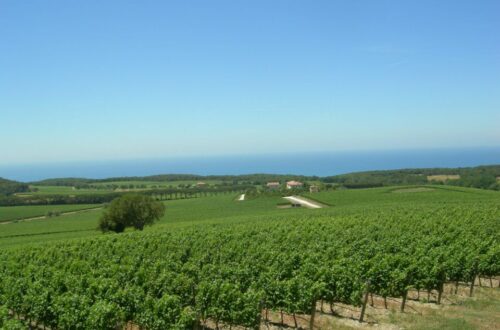Table of Contents
What is Malvasia delle Lipari DOC?
Malvasia delle Lipari DOC is a rare Sicilian dessert wine made primarily from Malvasia di Lipari grapes grown on the volcanic slopes of the Aeolian Islands, north of Sicily. This Passito-style sweet wine is produced by drying grapes in the Mediterranean sun to concentrate sugars and aromas. The result? A golden nectar with apricot, honey, citrus blossom, and a distinctive volcanic minerality that reflects its island home.
History & Origins
Malvasia’s story here stretches back to Greek colonists in the Aeolian Islands, who brought vine cuttings in the first millennium BCE. Over centuries, the islands’ maritime trade routes carried this wine to noble courts across Europe. By the 18th century, Malvasia delle Lipari was a sought-after luxury in Paris and London. In modern times, production nearly vanished—today, fewer than 8 hectares remain, safeguarded by a handful of passionate winemakers.
Where It’s Made: Geography & Terroir
The Aeolian Islands are UNESCO World Heritage sites, celebrated for their dramatic volcanic landscapes. The vines thrive in mineral-rich pumice and obsidian soils, under constant sea breezes and intense sun. Key islands for production include Lipari and Salina, with terraces perched above crystalline waters.
- Altitude: 50–350 meters above sea level
- Climate: Mediterranean, hot summers, mild winters
- Soils: Volcanic, sandy, high in minerals
The Grape
DOC regulations require 92–95% Malvasia di Lipari and 5–8% Corinto Nero. The Corinto Nero adds structure and spice, balancing Malvasia’s opulent sweetness.
Winemaking & DOC Regulations
- Grapes are hand-harvested in late August or early September.
- Bunches are dried on straw mats (cannizzi) for 10–20 days in the Aeolian sun.
- Fermentation is slow and temperature-controlled, often in small oak or steel tanks.
- Wines must meet DOC specifications for alcohol (≥11.5%), sugar levels, and geographic origin.
Styles include:
- Passito – The iconic sweet style, with concentrated flavors.
- Liquoroso – Fortified for greater alcohol and longevity.
- Secco – A rare dry style with pronounced minerality.
Key Facts at a Glance
- Region: Aeolian Islands, Sicily
- Primary Grapes: Malvasia di Lipari, Corinto Nero
- DOC Established: 1973
- Annual Production: ~25,000 bottles
- Style: Sweet Passito (also dry and fortified styles)
- Rarity: Only ~8 hectares under vine
What Does Malvasia delle Lipari Taste Like?
Expect a rich, golden hue and aromas of apricot jam, orange peel, acacia honey, jasmine, and almond brittle. On the palate, sweetness is balanced by a saline minerality and gentle acidity, leading to a lingering finish of candied citrus and volcanic spice.
Serving & Pairing
- Serving Temp: 12–14°C (54–57°F)
- Best Glass: Small tulip-shaped dessert wine glass
- Pairings:
- Sicilian cassata
- Almond biscotti
- Foie gras
- Blue cheeses like Gorgonzola Dolce
- Sicilian cassata
Where Can I Buy Malvasia delle Lipari DOC?
Look for producers like Carlo Hauner, Colosi, Tenuta di Castellaro, and Fenech. In the US, bottles range from $35–$80, depending on vintage and rarity. Some top vintages may only be available at the winery.
How Much Does Malvasia delle Lipari Cost?
- Entry-level Passito: €25–€35 in Italy
- Prestige bottlings/vintage releases: €50–€90
- Aging potential: 10–20 years for top producers
Is Malvasia delle Lipari Worth the Investment?
Yes—due to its scarcity and age-worthiness, well-stored bottles can appreciate in value. Collectors seek rare vintages, and small production ensures demand often outstrips supply.
Producer Profiles (2025)
- Carlo Hauner: Pioneer of modern Aeolian winemaking; intense and complex Passito.
- Colosi: Known for balance and approachability.
- Tenuta di Castellaro: Sustainable practices and elegant, mineral-driven style.
Visiting the Aeolian Islands: Wine Tourism Tips
- Best Time to Visit: September (harvest season)
- Transport: Ferries from Milazzo, Sicily; hydrofoils from Naples
- Winery Experiences: Tastings with sea views, vineyard walks on volcanic slopes
- GPS Highlights: Lipari (38.466° N, 14.954° E), Salina (38.566° N, 14.833° E)
Fun Facts & Cultural Notes
- The islands’ volcanic soils are so light, they can be carried away by wind.
- Ancient Romans called Malvasia “nectar of the gods.”
- The DOC includes both sweet and dry styles—though sweet Passito is iconic.
FAQ on Malvasia delle Lipari DOC
Q: What is the aging potential?
A: 10–20 years for top vintages.
Q: How does it compare to Malvasia di Bosa?
A: Both are rare Italian sweet wines, but Bosa comes from Sardinia with nutty, oxidative notes, while Lipari is fresher and more tropical.
Q: Can I find it outside Italy?
A: Yes, but availability is limited to specialty wine shops and high-end online retailers.


